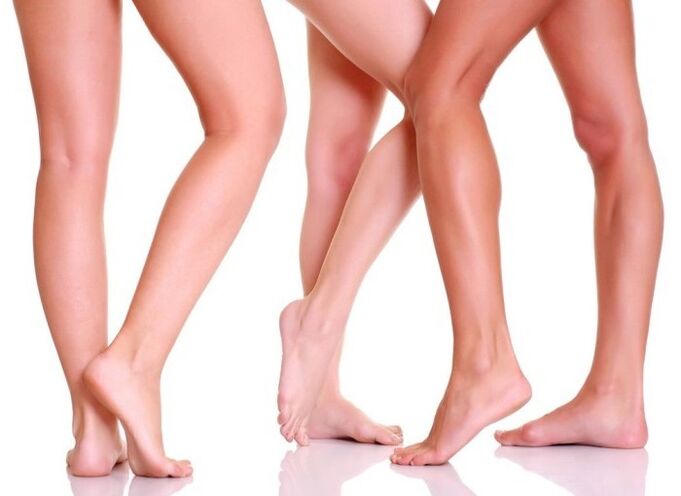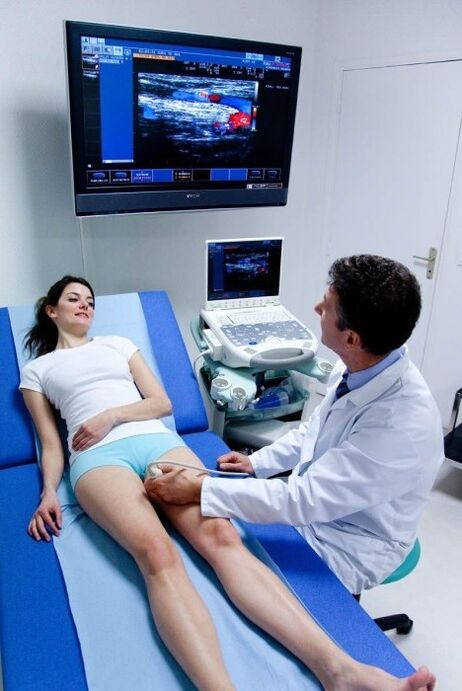
Why does it happen?
- overweight;
- The intestines cannot cope with its work, which is why constipation often occurs;
- flatfoot;
- hypertension;
- passive lifestyle;
- extensive physical activity;
- Prolonged tension in the legs.
Disease symptoms and diagnosis
- Leg swelling at the end of the work day;
- A feeling of fullness and heaviness in the calf area after sitting in one place for a long time or standing for a long time;
- Tingling in the legs;
- Cyanosis appears in the legs;
- Mesh and star shapes are formed on the legs.
If you develop these symptoms, it is important to see a phlebologist or vascular surgeon immediately. Complications can be prevented if treatment is started promptly.

- Ultrasound examination of veins, called a duplex venous scan. With ultrasound, an experienced specialist will see how open the vein is and how dilated it is. Additionally, such a study will tell you whether there is a blood clot in the vein and which direction the blood is flowing;
- Using contrast venography, varicose veins of the lower extremities can be accurately diagnosed. With venography, the condition of the veins can be assessed and the presence of blood clots and tumors can be determined. In the study, a substance was injected into the leg area to make the blood appear blue, thus leaving an imprint of the patient's veins on X-rays.
When you need to see a doctor urgently
- If you experience severe, sharp pain in your legs when doing any exercise;
- If you feel severe pain in your legs in the morning when you try to get out of bed. In this condition, the legs have a swollen, dense appearance and a burning sensation in the skin;
- If in addition to pain, there is also a feeling of general weakness, shortness of breath, and persistent lack of oxygen;
- If the leg affected by varicose veins begins to ooze blood.
Correct treatment of varicose veins
- Surgery is not required to treat this disease. This treatment only works on the first symptoms of varicose veins. Conservative treatment involves wearing special compression garments, following a special diet, and performing a range of physical activities on a regular basis.
According to the doctor's advice, you can choose special knee-high socks or socks that are suitable for your feet and have a certain amount of compression. You can also wrap your legs with elastic compression bandages. This type of underwear should be worn throughout the day and removed only before bed. Also useful is a special massage, which is performed with a special cuff filled with air. Thanks to air pressure massage, blood circulation improves, tissues breathe better, the pain and discomfort associated with varicose veins disappear; - The treatment of varicose veins in the lower limbs also requires the help of drugs, which are divided into intravenous supplements, anticoagulants and non-steroidal anti-inflammatory drugs.
Anticoagulants prevent blood clots from forming in the veins. Inflammation and pain are eliminated thanks to NSAIDs. - Varicose veins can also be treated with leeches. Leeches bite the skin, penetrate deep into the skin and release hirudin, which thins the blood and prevents blood clots from forming;
- Treatment is with sclerotherapy, where the affected vein is completely removed. The procedure is like this. Doctors inject a special drug into the veins that sticks them together and prevents blood from flowing. As a result, vein degeneration occurs. The veins resolve completely within a year. This procedure does not interfere with blood circulation. To completely cure varicose veins with sclerotherapy, you will need three to six such treatments;
- Varicose veins can also be treated with laser. The surgery is performed under local anesthesia. The first results will be visible within three weeks of treatment;
- If the above conservative methods are ineffective, doctors may resort to surgery. On the second postoperative day, the patient was able to walk independently.
The method of treating varicose veins based on your situation should be decided solely by your doctor. There is no need to treat such a serious illness on your own.
Expert advice
- Try to drink more than two liters of pure water every day. Water can help you lose excess weight and prevent varicose veins;
- It is important to fast once a week. You need to fast on this day. A day of fasting helps remove waste and toxins from the body;
- Try to quit smoking. After all, nicotine has adverse effects on blood vessels and can cause varicose veins;
- Try not to overheat and strengthen your immune system to avoid getting sick. Don't sit in a hot bath or sauna for too long;
- Sudden changes in climate are not recommended. Therefore, it is best to relax in your own climate zone.
Varicose veins and traditional medicine
- Mix one part chopped white garlic with two parts creamy butter. Apply the resulting product to the damaged vein, wrap the leg with parchment and a bandage or a warm scarf. This compression is done at night. In the morning, after washing, put on warm pants;
- For one year, tie green tomato slices to the affected vein before bed. Due to this vegetable, varicose veins will soften and shrink. After a while, they disappear completely;
- Mix kefir with mugwort. Put the resulting mixture on a bandage and wrap it around your legs. The procedure takes place overnight;
- To prevent leg injuries due to varicose veins at night, you need to eat the following apple porridge. Pour three Antonovka apples into a liter of boiling water and cook for three hours. Then take out the apples, make puree, and eat it twice a day, 30 grams each time;
- Pour 30 g of nettles into boiling water and cook for an hour. Then strain and drink a quarter cup three times a day. Drink for 1 month, then take a two-week break and repeat the process. Nettle treatment should be carried out for six months;
- Pour boiling water over hop cones and let soak for 15 minutes. Drink the tincture half an hour before meals. For faster results, soak a bandage in the intoxicating infusion and apply it to the affected vein;
- Pour boiling water into 5 g of finely chopped nutmeg. Add 5 grams of honey and stir. Let it brew for 30 minutes. Drink 60 minutes before breakfast and two hours after breakfast. Nutmeg is poisonous, so do not drink more than five grams per day. Failure to observe this warning may result in death;
- Place the longevity leaves in a one liter jar. Half leaf, half alcohol. Inject in the dark for two weeks. Shake the jar daily. Use the resulting product to lubricate your feet every day;
- You need to peel five potatoes. Grate them and brush your feet with the resulting puree. After four hours, rinse the potatoes with warm water;
- Pour 50 g of horse chestnut with alcohol (500 ml). Let it simmer for two weeks. After a period of time, filter out and take 15 grams each time, 3 times a day, with water. The course of treatment is 7 days. Then rest for 14 days. After completing three of these classes, your legs will improve.
Diet rules for varicose veins
Now you know why varicose veins occur, how to properly diagnose them, and what treatments are available for this condition. Only by strictly following all the recommendations of experienced doctors can you overcome this disease in a short time and continue living and enjoying a healthy lifestyle.

















